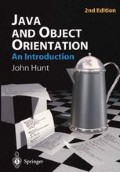Abstract
The Unified Modeling Language (UML) is part of a development to merge (unify) the concepts in the Boo ch, Objectory and OMT methods (Jacobson et al., 1998; Rational, 2001). The method is still under development (and has taken a low profile recently); however, the notation underlying this method is nearing completion. This notation is now the focus of the current work of Booch, Rumbaugh and Jacobson and is receiving a great deal of interest. Microsoft, Hewlett-Packard, Oracle and Texas Instruments have all endorsed the UML.
Access this chapter
Tax calculation will be finalised at checkout
Purchases are for personal use only
Preview
Unable to display preview. Download preview PDF.
Author information
Authors and Affiliations
Rights and permissions
Copyright information
© 2002 Springer-Verlag London
About this chapter
Cite this chapter
Hunt, J. (2002). The Unified Modeling Language. In: Java and Object Orientation: An Introduction. Springer, London. https://doi.org/10.1007/978-1-4471-0125-3_38
Download citation
DOI: https://doi.org/10.1007/978-1-4471-0125-3_38
Publisher Name: Springer, London
Print ISBN: 978-1-85233-569-4
Online ISBN: 978-1-4471-0125-3
eBook Packages: Springer Book Archive

